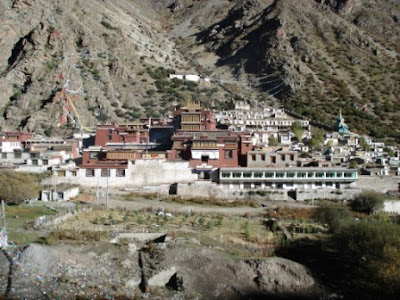
I took this picture while sitting on the top of a giant stadium-like staircase built into the side of the hill opposite the Tsurpu Gompa ('tshur phu dgon pa). The staircase is used for the unraveling of a giant thanka painting at least a hundred feet high. Below me is a small green with nomad tents and a beautiful river with a small bridge so covered in prayer flags that traveling across it becomes a delicate dance of trying not fall in and not step on them at the same time.
On the front right side of the monastery there are 13 windows and the farthest right window is where Ephriam and I stayed over for a Saturday evening. The guest house is quite clean and comfortable and the caretaker and his children where a delight to meet.
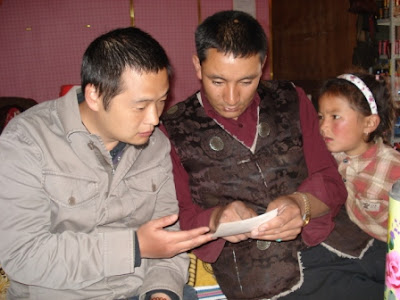
This is Ephriam, a friend from Hong Kong, and Tope-gyal (stobs rgyal) with one of his (four?) children. Tope-gyal cooked all our meals fresh, mostly a noodle soup called tuk-pa. He helped us find our room and taught us new Tibetan words by candle light when the electricity went out at night.
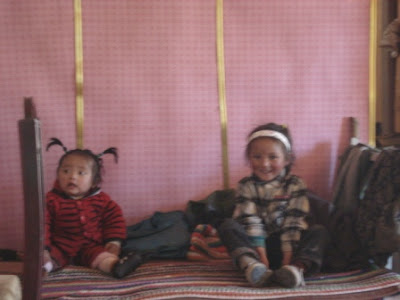
Two more of Tope gyal's children watching us eat lunch.
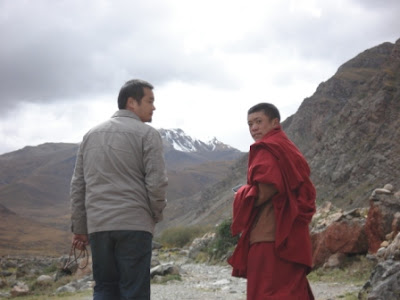
The first monk we met on arrival at the front gate of Tsurpu. He led us around to each of the lha kangs, or small temples, many filled with protectors and the constant chanting of old lamas and young monks.
Ephriam and I made it to the bus pick-up point near the Barkor in Lhasa at around 6:35, a half hour early for the supposed bus, but ten minutes late for the actual bus. Luckily so many pilgrims wanted to go to Tsurpu that day that another bus was organized. We were accosted by competing prayer flag sellers, a boy and a girl who came on to the bus and placed their wares in our faces for a good twenty minutes, while they argued with each other and screamed at us to buy, buy, buy! The sun came up while we waited for the bus to fill up and we didn't buy anything. The trip up to Tsurpu gompa is pretty easy, but your breath is easily taken away by the time you step off the bus across the stream from the tall stone steps of the main gate.
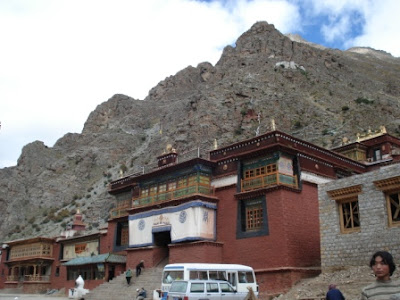
The stairs in these monasteries are extremely steep, but perhaps it shouldn't be easy to get into them. At one of the pilgrimage sites on our journey an old woman had to be carried up old wooden stairs as steep as ladders, each time she would try to make it up herself, but the rest of us would come to her rescue before she tipped over backwards.
Tsurpu is quite an amazing place, and quite large really. The local people were working hard on the construction underway in the main courtyard:
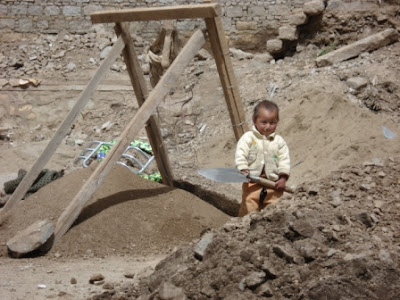
This little one was trying to help his mother sift dirt. At this altitude it takes a day to be able to do work. Running through all the temples and prostrating at all the shrines on the first day made Ephriam a little sick, but we rested in the afternoon and slept early enough. The next morning I woke up with the sun and hiked up above the monastery:
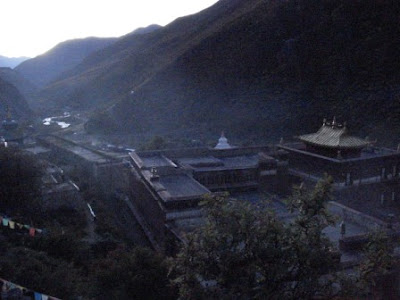
It was a bit cold at first, but as the sun touched the yak dung strewn mountain side the heat became too much for my coat and hat. That is not morning mist in the picture above, its too dry here for much of that. It is the morning sang, or incense offerings at the main temple, rising high into the valley's sky.
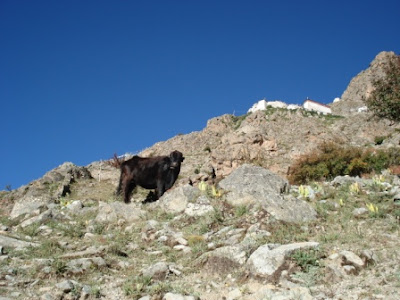
It doesn't look like it, but to get to this spot I had to do some class four/class five climbing. At the point that I took this picture I had no idea how good climbers yaks are. Since then I had a little adventure hiking near Shungsep nunnery, and believe me, if I could get yak hoof shoes I would.
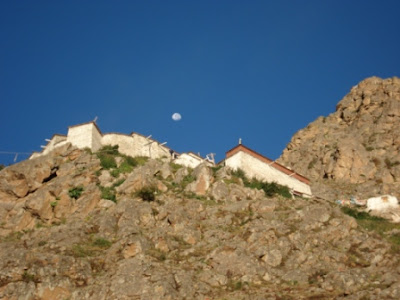
A meditation retreat area high above the main temples and houses of Tsurpu.
I wish I could tell you this picture does some justice to the cliffs and the view of the monastery from here. The photos from above didn't come out well, so you'll just have to visit, wake up before sunrise and hike up behind the monastery in the dark until the sun begins to hit the golden caps of the monastery buildings.
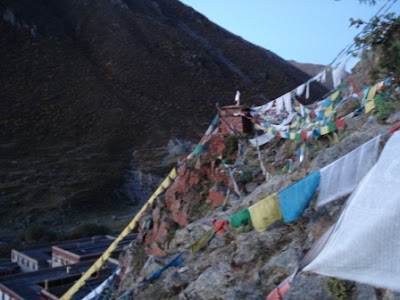
A sea of prayer flags zigzag up the side of the cliffs above Tsurpu.
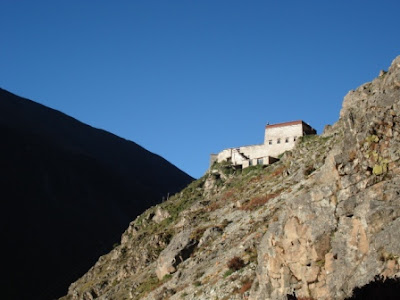
I came down from the north side around 9am and began a kora around the four main chortens, (or stupas), first green, then white, then yellow, then red; the blue being hidden somewhere in the center of the monastery. Each stupa is associated with a buddha family, an element, a direction, a particular history of practices, and a particular Buddhist cosmology presented in the abhidharma literature, related to the Indian cosmology of mount Meru and the four continents and eight subcontinents. We are supposed to live in the southern continent of Dzampuling, or Jampuling. Elvis still lives, just over on the south-western continent next to Dzampuling.
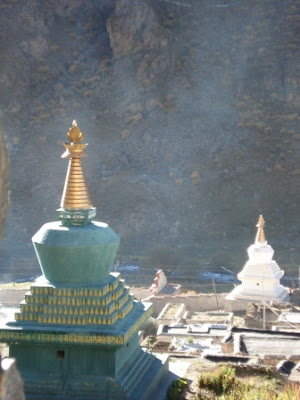
I narrowly avoided a dog and some yaks, jumped across a stream and came down by the green stupa.
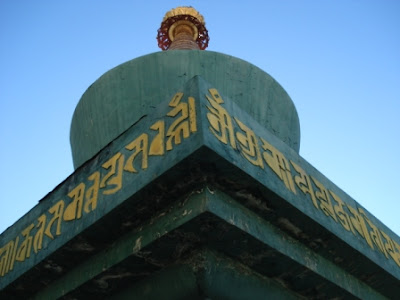
White.
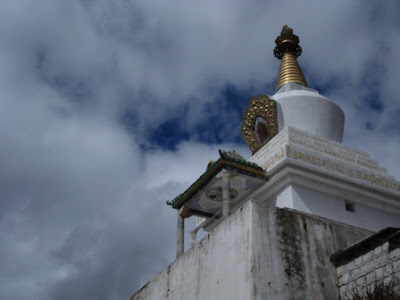
The yellow stupa with yaks and the eight small stupas representing the eight manifestations of Padmasambhava, aka Guru Rinpoche, aka Big Pappa, aka Pimp Dady Padmajungnay, aka Demon Slapping Pimp, aka Pimpin Loppon (he had many of "consorts" workin' the mountain sides, they are called "Dakinis").
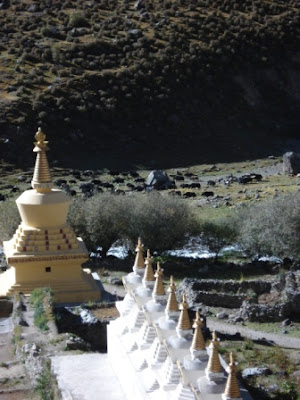
Red.
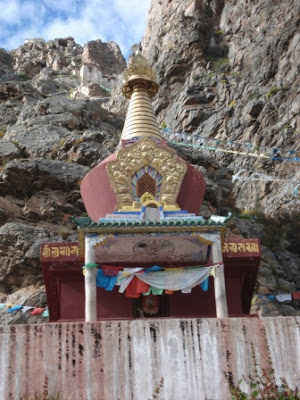
The view from the red stupa.
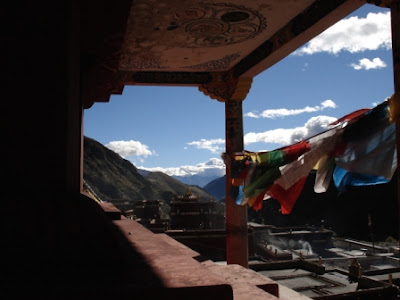
Chillin with Guru Rinpoche.
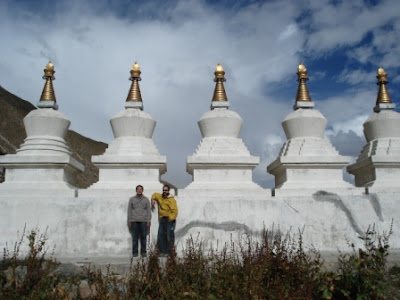
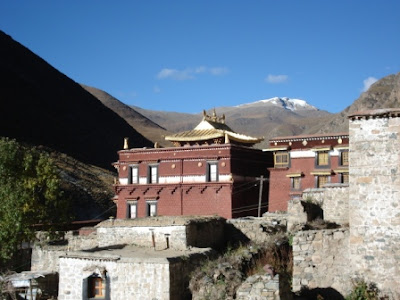
In a few weeks I will be trekking past Tsurpu and over that mountain in the background on my way to hot springs, a nunnery, and another monastery called Yangpachen.
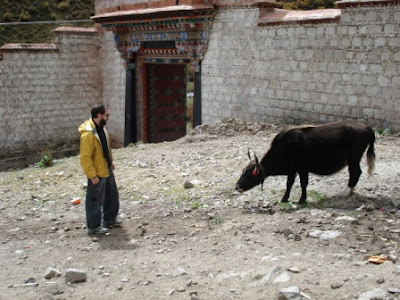
A close encounter after lunch.
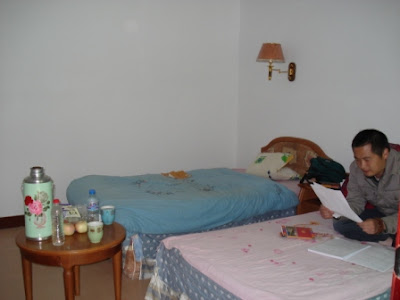
Our accommodations at the Tsurpu guest house.
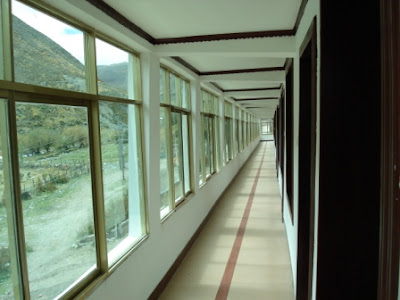
How about an afternoon stroll, past the mani stones and yaks, into the linka by the nomad tents and to the monument built for a little party for the birth of Karmapa.

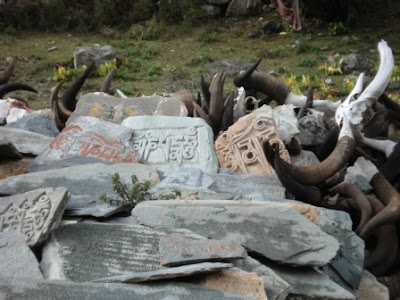
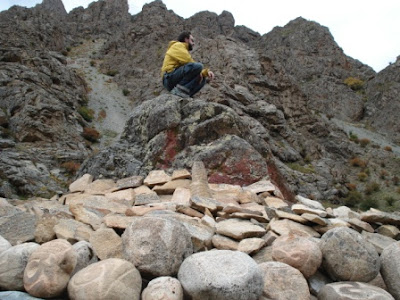
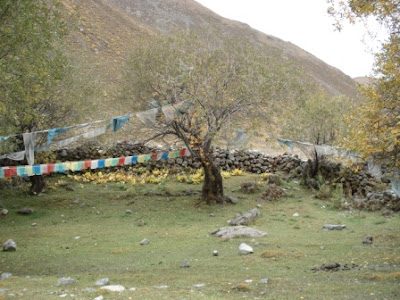
The Karmapa's Birthday celebration spot.
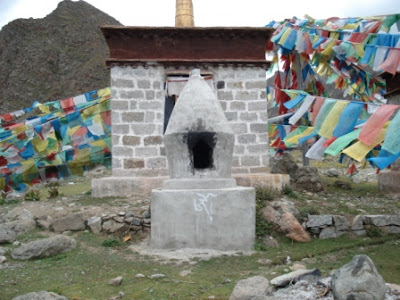
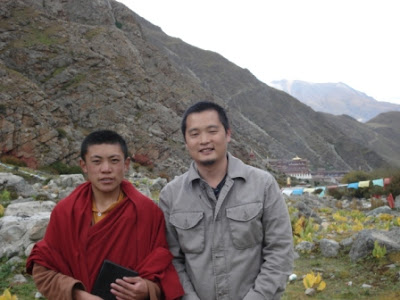
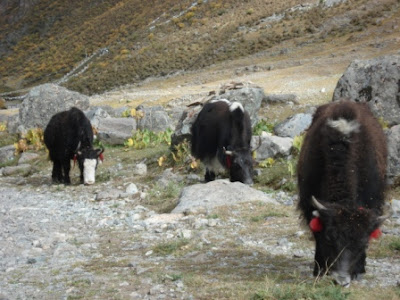
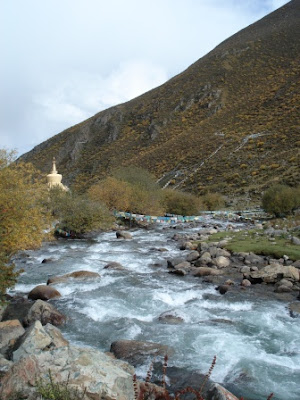
The famous ancient stele in the main courtyard:
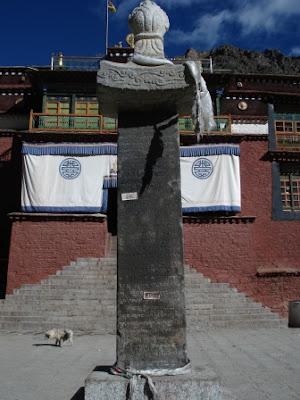
Time to hitch a ride back to Lhasa via one of the Karmapa's heart son's monastery. We had to stand on a bus for four hours but it was worth it.
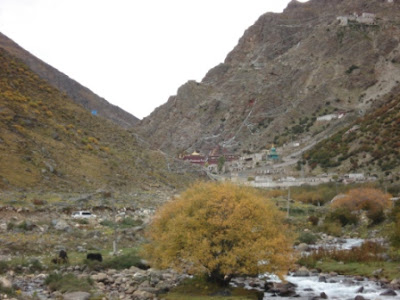
Bye bye Tsurpu! See you soon.
Here's the Karmapa's retreat, there were plenty of legos in one of the rooms and a beautiful garden with a monument to the third Karmapa who also spent time here.
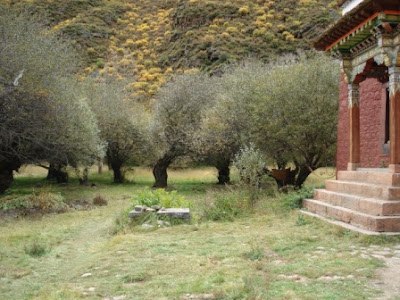
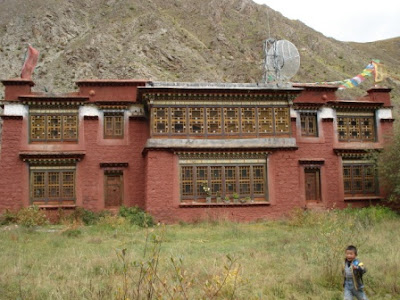
A young boy on pilgrimage playing in the garden where the Karmapa probably played when he was young.
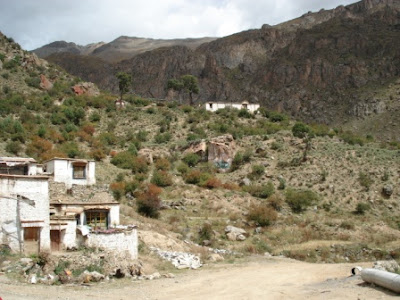
The heart son's place.
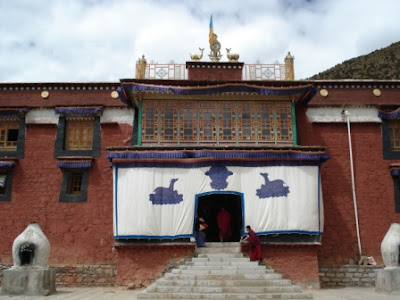
Now it's finally back to Lhasa.
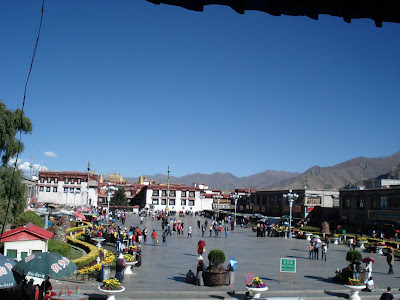
The Barkor area from an upstairs tea house in front of the Jokang.
 The Barkor area from an upstairs tea house in front of the Jokang.
The Barkor area from an upstairs tea house in front of the Jokang.

No comments:
Post a Comment